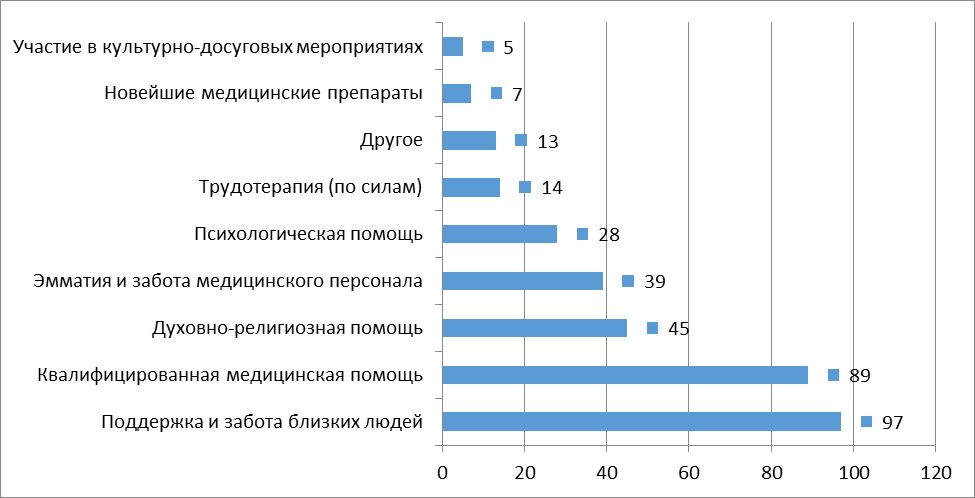Modern sisters of mercy in the system of palliative care in Russia: a sociological analysis
In modern society, the number of people who need not just constant medical, but specialized social and medical, or palliative assistance is constantly increasing. Unfortunately, the modern health care system cannot fully provide such assistance to all who need it. In this regard, the introduction of new non-state institutions into the social practice that are able to satisfy the existing social order becomes especially relevant. One of these subjects of palliative care is the sisterhoods of mercy of the Russian Orthodox Church. The specificity of the provision of palliative care by sisters of mercy lies in the comprehensive provision of social, medical and spiritual, and religious assistance.
Especially important when working with incurable patients are the personal qualities of employees of palliative care services, because their direct contact directly affects the quality of life of the patient. In this regard, on the basis of empirical data, we have identified some specific ideological characteristics of the sisters of mercy as a small social group and compiled a social portrait of modern sisters of mercy. The complex of value orientations of sisters of mercy is represented by various values. The most important of them for the sisters of mercy are the values of a spiritual and religious nature.
Information for citation: Gotovkina, M. S. (2018), “Modern sisters of mercy in the system of palliative care in Russia: a sociological analysis”, Research Result. Sociology and management, 4 (4), 3-15, DOI: 10.18413/2408-9338-2018-4-4-0-1
Figures
Рис. 1. Распределение ответов на вопрос «Сталкивались ли Вы или Ваши близкие с оказанием паллиативной помощи?»
Fig. 1. Distribution of answers to the question “Have you or your relatives experienced palliative care?”
Рис. 2. Факторы способные облегчить состояние инкурабельного больного (по мнению респондентов первой группы)
Fig. 2. Factors able to alleviate the condition of the incurable patient (according to the respondents of the first group)
Рис. 3. Факторы способные облегчить состояние инкурабельного больного (по мнению респондентов второй группы)
Fig. 3. Factors able to alleviate the condition of the incurable patient (according to the respondents of the second group)

Рис. 3. Распределение ответов респондентов на вопрос: «Что для вас является наиболее привлекательным в работе с тяжелобольными людьми?»
(в % от числа ответивших; n=225)
Fig. 3. Distribution of respondents' answers to the question: “What is most attractive for you in working with seriously ill people?”
(% of the number of respondents; n = 225)






















While nobody left any comments to this publication.
You can be first.
Vvedenskaya, E. S. “Palliative care is a modern public health focus” [Online], available at: http://www.simhos.ru/medicine/89-palliative-care.html (Accessed 23 September 2018). (In Russian).
Gotovkina, M. S. (2015), “To the problem of sociological analysis of palliative care”, Nauchnye vedomosti BelGU. Seriya «Filosofiya. Sotsiologiya. Pravo», 32 (8), 169-172. (In Russian).
Karpycheva, L. A. (2018), “Sisters of Mercy: history in the light of modernity” [Online], available at: http://ibif.org.ru/articles/nachalo14/14-08.pdf (Accessed 10 July 2018). (In Russian).
Novikov, G. A. (2018), “Palliative care in oncology – the founder of palliative medicine in health care” [Online], available at: http://www.painstudy.ru (Accessed 2 September 2018). (In Russian).
Puzanov, M. S. (2011), “Features and prospects for the development of the movement of sisters of mercy in modern Russia”, Uchenye zapiski RGSU, 7, 83-87. (In Russian).
Khetagurova, A. K. (2003), Palliative care: medical and social, organizational and ethical principles, Moscow, Russia. (In Russian).
Ekkert, N. V. (2010), “Scientific substantiation of the organizational-functional model of the palliative care system for the population”, D. Sc. Thesis, medical science, Moscow, Russia. (InRussian).